

Planets. Planets are round objects that move in circles around stars.
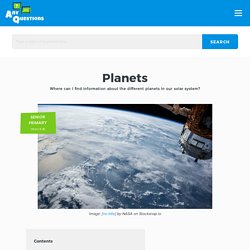
Britannica School. Planets – NASA. There are more planets than stars in our galaxy. The current count orbiting our star: eight. The inner, rocky planets are Mercury, Venus, Earth and Mars. The outer planets are gas giants Jupiter and Saturn and ice giants Uranus and Neptune. Beyond Neptune, a newer class of smaller worlds called dwarf planets reign, including longtime favorite Pluto. Planet Lineup Mercury. The Solar System and its planets. The Solar System is made up of the Sun and all of the smaller objects that move around it.
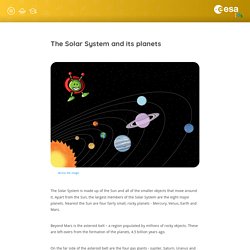
Apart from the Sun, the largest members of the Solar System are the eight major planets. Nearest the Sun are four fairly small, rocky planets - Mercury, Venus, Earth and Mars. Beyond Mars is the asteroid belt – a region populated by millions of rocky objects. These are left-overs from the formation of the planets, 4.5 billion years ago. On the far side of the asteroid belt are the four gas giants - Jupiter, Saturn, Uranus and Neptune. Until recently, the furthest known planet was an icy world called Pluto.
An object named Eris, which is at least as big as Pluto, was discovered very far from the Sun in 2005. Exploring the Solar System. Our Solar System. The Nine Planets of The Solar System. Why Mars? - How Terraforming Mars Will Work. Mars has long held a special fascination in the human imagination, as is witnessed by the scores of books and movies that have been produced about the planet in the last century alone.
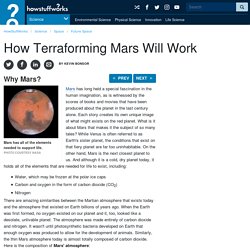
Each story creates its own unique image of what might exists on the red planet. Curious Kids: can people live in space? Curious Kids is a series for children.

If you have a question you’d like an expert to answer, send it to curiouskids@theconversation.edu.au You might also like the podcast Imagine This, a co-production between ABC KIDS listen and The Conversation, based on Curious Kids. Can people live outside Earth? Planet Earth facts and information. Earth, our home planet, is a world unlike any other. The third planet from the sun, Earth is the only place in the known universe confirmed to host life. With a radius of 3,959 miles, Earth is the fifth largest planet in our solar system, and it's the only one known for sure to have liquid water on its surface. Earth is also unique in terms of monikers. Every other solar system planet was named for a Greek or Roman deity, but for at least a thousand years, some cultures have described our world using the Germanic word “earth,” which means simply “the ground.”
Earth – NASA. How could we live on the Moon? It’s an ideal launchpad for missions to Mars and other worlds.

And, for some people, it’s the ultimate tourist destination. But where would we live and how could we survive the Moon’s hostile environment? Moon fact: Apollo 17 astronauts Eugene Cernan and Harrison Schmitt hold the record for the longest time on the Moon – 75 hours. When Apollo 17 returned from the Moon in 1972, few people would have imagined that we would still be waiting for another human to set foot on our cosmic companion nearly 50 years later. In fact, most people at the time thought that by now we would have a human settlement on the Moon. Why it’s one thing getting to the Moon… but it’s quite another living there Sending humans to the Moon comes with huge costs, risks and technological challenges. 6 Technologies NASA is Advancing to Send Humans to Mars. Mars is an obvious source of inspiration for science fiction stories.
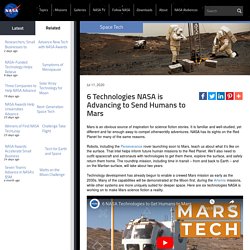
It is familiar and well-studied, yet different and far enough away to compel otherworldly adventures. NASA has its sights on the Red Planet for many of the same reasons. Robots, including the Perseverance rover launching soon to Mars, teach us about what it’s like on the surface. That intel helps inform future human missions to the Red Planet. We’ll also need to outfit spacecraft and astronauts with technologies to get them there, explore the surface, and safely return them home. NASA is advancing many technologies to send astronauts to Mars as early as the 2030s. Credits: NASA 1. Astronauts bound for Mars will travel about 140 million miles into deep space. It is too soon to say which propulsion system will take astronauts to Mars, but we know it needs to be nuclear-enabled to reduce travel time. Timeline of Solar System exploration. Charted timeline of Solar System exploration, as of December 2014 This is a timeline of Solar System exploration ordered by date of spacecraft launch.
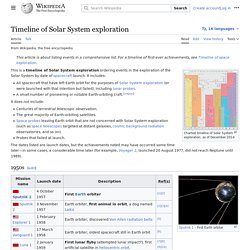
It includes: All spacecraft that have left Earth orbit for the purposes of Solar System exploration (or were launched with that intention but failed), including lunar probes.A small number of pioneering or notable Earth-orbiting craft. [vague] It does not include: Centuries of terrestrial telescopic observation.The great majority of Earth-orbiting satellites.Space probes leaving Earth orbit that are not concerned with Solar System exploration (such as space telescopes targeted at distant galaxies, cosmic background radiation observatories, and so on).Probes that failed at launch.
The dates listed are launch dates, but the achievements noted may have occurred some time later—in some cases, a considerable time later (for example, Voyager 2, launched 20 August 1977, did not reach Neptune until 1989). 1950s[edit] 1960s[edit] 1970s[edit] 1980s[edit]